NEC PA272W 27-Inch Monitor Review: Accuracy And Flexibility
We’ve reviewed a lot of professional-class monitors, NEC's PA272W may be the most accurate and capable one ever to hit the Tom's Hardware lab. At almost $1300, it’s expensive for a 27-inch QHD screen. But there are features here you won’t find elsewhere.
Results: Grayscale Tracking And Gamma Response
The majority of monitors, especially newer models, display excellent grayscale tracking (even at stock settings). It’s important that the color of white be consistently neutral at all light levels from darkest to brightest. Grayscale performance impacts color accuracy with regard to the secondary colors: cyan, magenta, and yellow. Since computer monitors typically have no color or tint adjustment, accurate grayscale is key.
The most impressive thing about NEC's PA272W is its color accuracy. But you'll put in some work to unlock the monitor’s full potential. We’re going to focus on its three main modes: Adobe RGB, sRGB, and DCI.
NEC includes a factory calibration data sheet with each PA272W. The measured errors are expressed using Delta E 94, which returns slightly lower values compared to the Delta E 2000 standard we use at Tom’s Hardware.
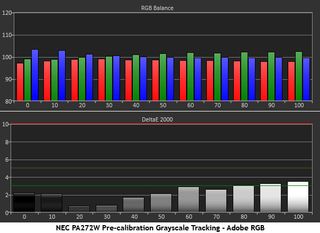
Given the difference between dE94 and dE2000, we pretty much match NEC’s results. This is excellent performance for an uncalibrated screen. The errors barely cross the visible level at 90 and 100 percent. You can see the slightest green tint in those patterns.
Calibration with the RGB sliders produces the following result.

And there's the perfection we expect from a professional monitor like the PA272W. It only takes a couple of small adjustments to lock in amazing tracking in the Adobe RGB or sRGB modes.
The next chart demonstrates why professionals in the film industry should consider this display.
Stay on the Cutting Edge
Join the experts who read Tom's Hardware for the inside track on enthusiast PC tech news — and have for over 25 years. We'll send breaking news and in-depth reviews of CPUs, GPUs, AI, maker hardware and more straight to your inbox.
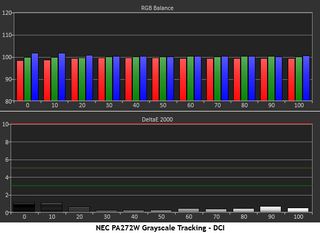
Digital Cinema Initiative (DCI) is a set of specifications for digital film-making and projection in commercial theaters. It employs a completely different set of parameters for color temperature, gamma, and color gamut, which we’ll show you on the next page. The PA272W is the first computer monitor we've seen that includes a DCI preset. The above result was obtained without any adjustment whatsoever. Talk about impressive.
Here is our comparison group:
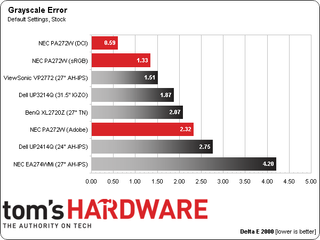
We’re showing you the before and after grayscale results for Adobe RGB, sRGB, and DCI. The DCI and sRGB results are excellent for an uncalibrated monitor, while the Adobe RGB result is a tad weak. Granted, it’s still an invisible error. But a monitor like this should measure a little better.
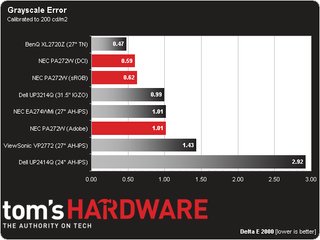
The DCI number is unchanged because we couldn’t improve upon it, even after calibration. The Adobe RGB and sRGB values show nice gains with only small changes to the RGB sliders. Even though the PA272W is very accurate out of the box, calibration helps it achieve near-perfection.
Gamma Response
Gamma is the measurement of luminance levels at every step in the brightness range from 0 to 100 percent. It's important because poor gamma can either crush detail at various points or wash it out, making the entire picture appear flat and dull. Correct gamma produces a more three-dimensional image, with a greater sense of depth and realism. Meanwhile, incorrect gamma can negatively affect image quality, even in monitors with high contrast ratios.
In the gamma charts below, the yellow line represents 2.2, which is the most widely used standard for television, film, and computer graphics production. The closer the white measurement trace comes to 2.2, the better.
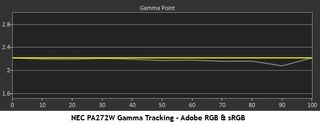
The PA272W’s gamma controls are extremely precise. We didn’t have to alter them, even after making changes to the grayscale and color management controls. If you want to use a standard other than 2.2, the presets range from .5 to 4.0 in .1 steps. The dip at 90 percent represents a luminance error of only 2.34 cd/m2.
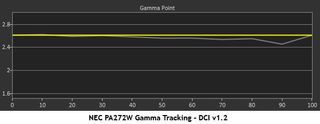
The DCI v1.2 spec calls for a gamma value of 2.6. In practice, that makes the image look a little darker. But remember, it’s designed for high-powered theater projectors, not LCD monitors. If you’re mastering movie content, though, having this option is a must. Looking at both charts, you can see the gamma tracking is identical at either level.
Here is our comparison group again:
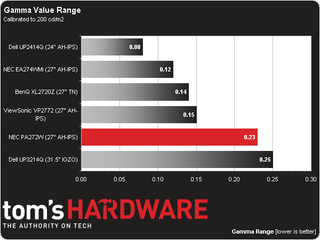
We’re showing you measurements in Adobe RGB, but they're almost identical in the sRGB and DCI modes. While the results aren't as tight as we've seen in the lab, they're well within our standard. If it weren’t for the dip at 90-percent brightness, the result would be perfect.
Gamma deviation is calculated by simply expressing the difference from 2.2 as a percentage.
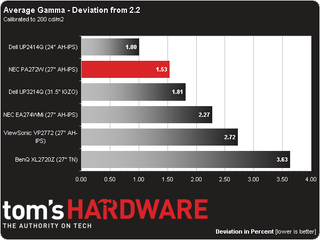
Again, 90-percent brightness is the only flaw in the PA272W's otherwise perfect gamma performance. The luminance error we measured is completely invisible to the eye both in test patterns and in actual content.
Current page: Results: Grayscale Tracking And Gamma Response
Prev Page Results: Brightness And Contrast Next Page Results: Color Gamut And Performance
Christian Eberle is a Contributing Editor for Tom's Hardware US. He's a veteran reviewer of A/V equipment, specializing in monitors. Christian began his obsession with tech when he built his first PC in 1991, a 286 running DOS 3.0 at a blazing 12MHz. In 2006, he undertook training from the Imaging Science Foundation in video calibration and testing and thus started a passion for precise imaging that persists to this day. He is also a professional musician with a degree from the New England Conservatory as a classical bassoonist which he used to good effect as a performer with the West Point Army Band from 1987 to 2013. He enjoys watching movies and listening to high-end audio in his custom-built home theater and can be seen riding trails near his home on a race-ready ICE VTX recumbent trike. Christian enjoys the endless summer in Florida where he lives with his wife and Chihuahua and plays with orchestras around the state.
-
SuckRaven Every time Tom's Hardware reviews monitors, I keep posting in the comments that they should review NEC and EIZO for accuracy in comparison to the usual suspects. Finally my prayers have been answered. (Not that there are not other places that have not already done a good job of including reviews of high-end monitors with color accuracy, and uniformity as the main focus), but Tom's has always been a preferred resource. Anyways, you guys should do a shootout with the top flagships from HP, Dell, NEC and and EIZO, perhaps the CG277). Nice review.Reply -
Pikker I've recently purchased this monitor with calibration tools and hood for a discounted price, needless to say it looks incredible, putting to shame an older 27" IPS display that I had.Reply
Regarding the NEC 272 vs. Eizo 277, I think they are more same than different... the Eizo has an integrated calibrator, 16-bit LUT, bigger color space, and a bunch of other tweaks that should objectively make it a better display, but not ~$1000 better IMO. If you have that kinda money to burn, get two PA272W's instead. -
ubercake Good review.Reply
I think everyone should notice the low-cost IPS monitors offer sub-par contrast. Who cares about color accuracy if you can't see the in-betweens? Aren't the shades/hues just as important? This is something people don't realize when they pick up that $400 IPS display. Heck, contrast is better on the BenQ TN display than on the less expensive IPS displays in the review. Color without good contrast is a waste. Contrast is what you compromise at the lower end of the IPS monitor scale.
You have to spend money to get a quality IPS monitor. It's good to see that you can get this kind of performance at a lower price point now.
This NEC monitor is definitely impressive. It has great color accuracy AND contrast. Great for photography and graphic arts/design applications. This is a pro monitor and why you spend money on an IPS monitor. -
ceberle Reply13488868 said:Every time Tom's Hardware reviews monitors, I keep posting in the comments that they should review NEC and EIZO for accuracy in comparison to the usual suspects. Finally my prayers have been answered. (Not that there are not other places that have not already done a good job of including reviews of high-end monitors with color accuracy, and uniformity as the main focus), but Tom's has always been a preferred resource. Anyways, you guys should do a shootout with the top flagships from HP, Dell, NEC and and EIZO, perhaps the CG277). Nice review.
Look for a review of the HP Z27x in a few weeks. It's in our lab now.
-Christian- -
PapaCrazy Bought one of these and ended up with a display that had several dead pixels and a couple hot pixels. Exchanged it, got a display with even more deal pixels, I stopped counting in the teens. For $1400, seems offensive. Dell was offering a zero dead pixel guarantee for half the price with the u2711. Calibrated, it seems to do quite well in color accuracy, I never get complaints after file deliveries, but the Dell is made like a piece of shit. Has a major heating problem which effects the top (where the heat collects) of the display's color output after intensive usage. I'm sick of this over-inflated display market. They are either under-engineered or overpriced.Reply -
Pikker ReplyBought one of these and ended up with a display that had several dead pixels and a couple hot pixels. Exchanged it, got a display with even more deal pixels, I stopped counting in the teens. For $1400, seems offensive.
That's some bad luck... I got mine from B&H and the display was perfect out of the box. Otherwise, the thing is built like a tank with an all-metal frame under the plastic outer shell, and it doesn't flex no matter what, if anything, I'd say it's over-engineered. -
PapaCrazy Reply13514585 said:Bought one of these and ended up with a display that had several dead pixels and a couple hot pixels. Exchanged it, got a display with even more deal pixels, I stopped counting in the teens. For $1400, seems offensive.
That's some bad luck... I got mine from B&H and the display was perfect out of the box. Otherwise, the thing is built like a tank with an all-metal frame under the plastic outer shell, and it doesn't flex no matter what, if anything, I'd say it's over-engineered.
Got mine from B&H too. NEC released an upgraded model w/ improved colorimeter shortly after my purchase. It could very well have been an accumulation of old stock, the backwash of sorts, that I drank from. When studying up, I found the only way to get a guarantee of zero dead pixels on NEC displays, you need to pony up for the ultra-expensive medical grade displays. It is well made though, I thought the portrait mode was a great feature and the stand was far more solid than the Dell's. Ran cooler as well. (thermally I mean)
Most Popular

